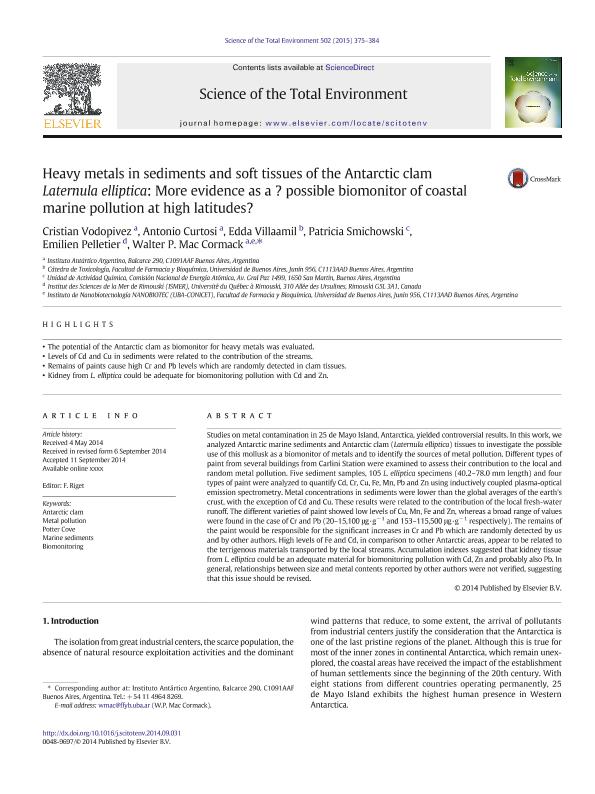Mostrar el registro sencillo del ítem
dc.contributor.author
Vodopivez, Leopoldo Cristian

dc.contributor.author
Curtosi, Antonio

dc.contributor.author
Villaamil Lepori, Edda Cristina

dc.contributor.author
Smichowski, Patricia Nora

dc.contributor.author
Pelletier, Emilien
dc.contributor.author
Mac Cormack, Walter Patricio

dc.date.available
2018-02-28T19:43:13Z
dc.date.issued
2015-01
dc.identifier.citation
Vodopivez, Leopoldo Cristian; Curtosi, Antonio; Villaamil Lepori, Edda Cristina; Smichowski, Patricia Nora; Pelletier, Emilien; et al.; Heavy metals in sediments and soft tissues of the Antarctic clam Laternula elliptica: More evidence as a ? Possible biomonitor of coastal marine pollution at high latitudes?; Elsevier Science; Science of the Total Environment; 502; 1-2015; 375-384
dc.identifier.issn
0048-9697
dc.identifier.uri
http://hdl.handle.net/11336/37483
dc.description.abstract
Studies on metal contamination in 25 de Mayo Island, Antarctica, yielded controversial results. In this work, we analyzed Antarctic marine sediments and Antarctic clam (Laternula elliptica) tissues to investigate the possible use of this mollusk as a biomonitor of metals and to identify the sources of metal pollution. Different types of paint from several buildings from Carlini Station were examined to assess their contribution to the local and random metal pollution. Five sediment samples, 105 L. elliptica specimens (40.2-78.0mm length) and four types of paint were analyzed to quantify Cd, Cr, Cu, Fe, Mn, Pb and Zn using inductively coupled plasma-optical emission spectrometry. Metal concentrations in sediments were lower than the global averages of the earth's crust, with the exception of Cd and Cu. These results were related to the contribution of the local fresh-water runoff. The different varieties of paint showed low levels of Cu, Mn, Fe and Zn, whereas a broad range of values were found in the case of Cr and Pb (20-15,100μg·g-1 and 153-115,500μg·g-1 respectively). The remains of the paint would be responsible for the significant increases in Cr and Pb which are randomly detected by us and by other authors. High levels of Fe and Cd, in comparison to other Antarctic areas, appear to be related to the terrigenous materials transported by the local streams. Accumulation indexes suggested that kidney tissue from L. elliptica could be an adequate material for biomonitoring pollution with Cd, Zn and probably also Pb. In general, relationships between size and metal contents reported by other authors were not verified, suggesting that this issue should be revised. elliptica could be adequate for biomonitoring pollution with Cd and Zn.
dc.format
application/pdf
dc.language.iso
eng
dc.publisher
Elsevier Science

dc.rights
info:eu-repo/semantics/openAccess
dc.rights.uri
https://creativecommons.org/licenses/by-nc-sa/2.5/ar/
dc.subject
Antarctic Clam
dc.subject
Biomonitoring
dc.subject
Marine Sediments
dc.subject
Metal Pollution
dc.subject
Potter Cove
dc.subject.classification
Meteorología y Ciencias Atmosféricas

dc.subject.classification
Ciencias de la Tierra y relacionadas con el Medio Ambiente

dc.subject.classification
CIENCIAS NATURALES Y EXACTAS

dc.title
Heavy metals in sediments and soft tissues of the Antarctic clam Laternula elliptica: More evidence as a ? Possible biomonitor of coastal marine pollution at high latitudes?
dc.type
info:eu-repo/semantics/article
dc.type
info:ar-repo/semantics/artículo
dc.type
info:eu-repo/semantics/publishedVersion
dc.date.updated
2018-02-28T14:13:43Z
dc.journal.volume
502
dc.journal.pagination
375-384
dc.journal.pais
Países Bajos

dc.journal.ciudad
Amsterdam
dc.description.fil
Fil: Vodopivez, Leopoldo Cristian. Ministerio de Relaciones Exteriores, Comercio Interno y Culto. Dirección Nacional del Antártico. Instituto Antártico Argentino; Argentina
dc.description.fil
Fil: Curtosi, Antonio. Ministerio de Relaciones Exteriores, Comercio Interno y Culto. Dirección Nacional del Antártico. Instituto Antártico Argentino; Argentina
dc.description.fil
Fil: Villaamil Lepori, Edda Cristina. Universidad de Buenos Aires. Facultad de Farmacia y Bioquímica; Argentina
dc.description.fil
Fil: Smichowski, Patricia Nora. Comisión Nacional de Energía Atómica; Argentina. Consejo Nacional de Investigaciones Científicas y Técnicas; Argentina
dc.description.fil
Fil: Pelletier, Emilien. Université du Québec à Rimouski; Canadá
dc.description.fil
Fil: Mac Cormack, Walter Patricio. Ministerio de Relaciones Exteriores, Comercio Interno y Culto. Dirección Nacional del Antártico. Instituto Antártico Argentino; Argentina. Consejo Nacional de Investigaciones Científicas y Técnicas. Oficina de Coordinación Administrativa Houssay. Instituto de Nanobiotecnología. Universidad de Buenos Aires. Facultad de Farmacia y Bioquímica. Instituto de Nanobiotecnología; Argentina
dc.journal.title
Science of the Total Environment

dc.relation.alternativeid
info:eu-repo/semantics/altIdentifier/doi/http://dx.doi.org/10.1016/j.scitotenv.2014.09.031
dc.relation.alternativeid
info:eu-repo/semantics/altIdentifier/url/https://www.sciencedirect.com/science/article/pii/S0048969714013412
Archivos asociados
